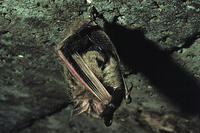GRAY BAT

The Gray Myotis is the largest of the Myotis species occurring in the eastern U.S. It is distinguished from all other bats within its range by its unicolored grayish brown dorsal fur. All other eastern bats have bi- or tri-colored fur on their backs. The Gray Myotis is almost totally cave dwelling and occupies a limited geographic range in limestone cave regions of the southeastern U.S. In Kansas, the only known populations are dependent on storm sewers within the Cherokee Plain region in the southeast corner of the state. Nearby streams with adjacent woodlands provide critical foraging habitat. These bats seem to especially utilize woody stream corridors and even linear tree plantings as travel lanes between storm sewer openings and their preferred foraging areas. Foraging is generally over water.

Gray Myotis are protected by the Kansas Nongame and Endangered Species Conservation Act, the Federal Endangered Species Act, and state and federal regulations applicable to those acts. Any time an eligible project is proposed that will impact the species’ preferred habitats within its probable range, the project sponsor must contact the Ecological Services Section, Kansas Department of Wildlife, Parks and Tourism, 512 SE 25th Ave., Pratt, Kansas 67124-8174. Department personnel can then advise the project sponsor on permit requirements under Kansas statutes. Sponsor of projects impacting Gray Myotis habitats must also contact the Endangered Species Specialist, U.S. Fish and Wildlife Service, 315 Houston Street, Suite E, Manhattan, KS 66502.
DESIGNATED CRITICAL HABITATSAs defined by Kansas Administrative Regulations, critical habitats include those areas documented as currently supporting self-sustaining population(s) of any threatened or endangered species of wildlife as well as those areas determined by the Kansas Department of Wildlife, Parks and Tourism to be essential for the conservation of any threatened or endangered species of wildlife.
Currently, the following areas are designated critical for Gray Myotis:
(1) All portions of the storm sewer system under the City of Pittsburg in Crawford County that were in place as of May 1, 1981.
(2) All suitable woodlands and water bodies within that portion of Crawford County encircled by a line beginning at the Kansas-Missouri border in NE/4 Sec. 24, T29S, R25E, then extending due west to the NW corner Sec. 19, T29S, R24E, then due south to the SW corner Sec. 18, T31S, R24E, then due east to the Kansas-Missouri border at the SE/4 Sec. 13, T31S, R25E, then due north along the Kansas-Missouri border to the point of origin.
(3) All woodlands and waters within a corridor along the main stem Cow Creek from its entry into Cherokee County at Sec. 21, T31S, R25E to its confluence with Spring River in Sec. 2, T33S, R25E, Cherokee County. The outermost boundaries of the corridor shall be along lines 150 yards landward from the stream’s ordinary high water mark on the right and left banks respectively.
(4) All woodlands and waters within a corridor along the main stem Spring River from its point of entry into Kansas at Sec. 1 T33S, R25E, to the Kansas Highway K-96 crossing in the S 1/2 Sec. 11, T33S, R25E, all in Cherokee County. The outermost boundaries of the corridor shall be along lines 150 yards landward from the stream’s ordinary high water mark on the right and left banks respectively. The U.S. Fish and Wildlife Service has authority to designate areas of critical habitat for federally listed endangered species, but has not done so for Gray Myotis in Kansas.







